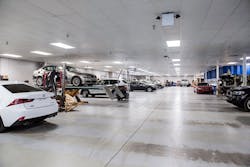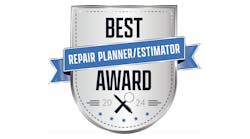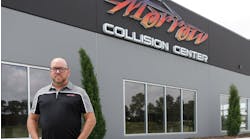Eighteen bays, three paint booths, three detail canopies, 12,000 square feet of office space, and 38,000 square feet of repair floor.
Not a bad deal, right?
“Don’t get me wrong—in the beginning it was a blessing,” DeWayne White says. “But it took some getting used to.”
When The Tom Bush Family of Dealerships dedicated $1.4 million of its $5 million renovation to a brand-new 50,000-square-foot collision repair facility, White, manager of Tom Bush Collision Center, thought about everything the added space would improve: the homely waiting area, the scheduling issues, the cramped repair bays, the lack of flow between body and paint.
What he didn’t fully expect were the growing pains that came with the new facility, and how added space can create as many problems as it solves. Getting through those initial roadblocks and learning to use 50,000 square feet to its full potential required a lot of time, thought and effort, but White claims the Tom Bush Collision team pulled it off by finding solutions to new hindrances, while also taking advantage of extra space to remedy problems that existed in its previous 25,000-square-foot facility.
Tom Bush Collision Center
LOCATION: Jacksonville, FLA.
STAFF: 28
AVERAGE MONTHLY CAR COUNT: 225
MANAGER: Dewayne White
SIZE: 50,000 square feet
THE BACKGROUND
The late Tom Bush Jr. opened Tom Bush Family of Dealerships 45 years ago in Jacksonville, Fla. Back then, the dealership exclusively worked on Volkswagens, but today, with the second, third and fourth generations of Bushes running the business, the dealership has grown to offer Mazda, BMW and MINI, as well.
The collision shop, which hired White four years ago, was established a little over 20 years ago to service the dealership’s growing brand lineup, and was eventually moved into a 25,000-square-foot facility as the workload increased. Before moving to the new 50,000-square-foot building, the collision center’s average monthly car count sat around 180.
The new shop opened in April 2016. The $1.4 million investment was meant to increase the shop’s capacity to repair more vehicles, with hopes a return would be achieved within the first two years of operation.
THE PROBLEM
The Tom Bush Collision staff experienced two sets of problems—a lack of space prior to the move, and an abundance of space afterward.
The Old Facility
Starting up front, White says the lobby was not customer friendly. The customer waiting area sat 10 feet away from the front desk, so there was “no sense of privacy whatsoever,” as White puts it.
The lack of space also affected the estimators’ abilities to connect with customers.
“The writers would write on top of one another in a back office, so a customer wasn’t ever able to just sit down with them at their desks,” White says.
With a lack of bays and storage space, the old facility also experienced scheduling issues, and customers had to wait an extended amount of time to get their cars in.
“We would lose customers because of having to schedule out two and three weeks,” White says. “Customers wanted it done quicker. The would reach out to their insurance and find another preferred shop.”
And once the vehicles entered the repair process, the old layout presented some difficulties. The shop floor was split by a wall, with body on one side and paint on the other, disrupting workflow and making it labor intensive to bring cars outside and around to paint, and then back again. Plus, the layout created a noise problem, making it hard to communicate on the floor.
With such a large staff (10 technicians, three painters), the 10 repair bays became constricting, and vehicles weren’t constantly being moved through the two paint booths and one prep bay. It was also difficult to accommodate the shop’s PDR tech, who didn’t have his own bay and shared with other techs.
The New Facility
While the new front lobby has produced nothing but stellar results, the repair process itself was complicated by the move.Outside of adding three more technicians and an extra painter, White had to game plan how to best make use of a third paint booth and eight additional bays, many of which sat vacant as the shop worked on increasing its car count.
There were also several structural beams spaced 20 feet apart between the body and paint units, making vehicle movement more difficult.
On top of it all, the immense amount of space became a productivity killer.
“Employees are twice the distance away from the parts department and the writers than they were in the beginning,” White says. “You really don’t think out how much time you spend walking back and forth getting clips and rivets three or four times a day.”
The walking distance began to worsen communication with estimators, and, as a result, supplements increased to an average of two per job.
THE SOLUTION
The open layout also gives estimators their own office, making for better one-on-one communication with customers.
“They can come sit at the estimator's desk, and the estimator can walk them through while [he or she is] writing an estimate,” he says. “It’s much more interactive than it was before.”
While the added staff and repair bays allows the shop to fix some of its scheduling issues, it didn’t initially produce the intended results: During the first two months, the shop actually had worse sales than the previous facility’s average, mostly thanks to decreased productivity and increased supplements.
To remedy this, White worked with consultants on a revised repair process, which paired a seasoned estimator with an A-technician to tear down vehicles and write estimates for all heavy hits over $2,500.
“They take [the cars] apart in a nice, slow, organized fashion, addressing clips, rivets, and anything else as they take the car apart,” White says. “You’re not leaving anything up for chance. You’re addressing everything that’s damaged and needs to be replaced right then and there.”
To work around the structural beams on the shop floor, White worked with consultants and determined that simply turning the paint booths 90 degrees would allow them to safely maneuver vehicles around the beams. Then staff separated body and paint with a curtain to prevent dust from traveling.
The new building also came with built-in drop ceilings, which fixed the noise issue.
“When someone is using a chipping gun, you can be two stalls down and have a normal conversation without yelling,” he says.
He’s also made use of the open repair bays by giving the PDR tech his own stall and setting up wheel reconditioning services, which the shop previously didn’t perform in-house.
The added paint booth has made the paint team more efficient. Not only is the airflow better in the newly purchased booths, but the team now performs priming and buffing in one of the paint booths as opposed to a prep deck.
“With the growth expected, we’ll be utilizing all three paint booths at some point. It just sets us up for the future,” White says.
THE AFTERMATH
While the first two months were rocky, the staff eventually settled in, and the shop has increased its monthly car count from 180 to 225. Between June and October, revenue went up 28 percent.
Supplements were cut dramatically, as staff now averages less than one per vehicle. Productivity rose to meet the previous facility’s average, and overall efficiency is up 10 percent.
And now that staff is used to the open layout, average cycle time is down from 14 to 11 days.
THE TAKEAWAY
While added space is often seen as a blessing, White says it can also create new bottlenecks. That’s why it’s important to never focus on an be-all and end-all cure—always evaluate, discuss, adapt, reevaluate and continue to improve.



